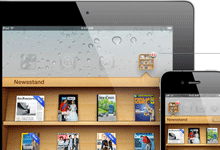Apple is announcing the latest version of its phone and mobile operating system today, which among many upgrades includes a new Newsstand section for buying and organizing newspaper and magazine apps.
Although Apple previewed the feature at its developers conference in June, very little detail was available about how it would work and how news apps would have to change to comply. But Apple recently released new documentation for developers that sheds more light on exactly how the new home of news apps will function.
iOS 5, with Newsstand, will be released Oct. 12, Apple executives said Tuesday at an event announcing the new iPhone 4S (not iPhone 5 as previously thought). Here are the key details we now know about Newsstand.
Newsstand is opt-in. It’s up to each developer to decide whether to recategorize an app as a “Newsstand app.” Apps that do not participate will be unaffected, while the new Newsstand apps will be featured in a dedicated section in the app store, just like Games or Lifestyle.
Automatic background downloading of subscriptions. Newsstand apps can use a special type of push notification to tell a device a new issue is ready, and it can be downloaded “in the background.” So it’s there awaiting the user, like a newspaper on your doorstep or a magazine in your mailbox.
-

- Apple is expected to introduce its Newsstand today, with an interface similar to iBooks, but designed for reading news.
Apple will only allow this background downloading once a day for each device, to prevent draining battery life. Newsstand apps will still download up-to-the-minute content when they are opened, but the user will need an active Internet connection and have to wait for that to load. Newsstand apps are the only apps to use background content downloads, so if a publisher decides not to participate in the Newsstand, his organization’s app will not benefit from background downloading.
Free apps can participate. While Newsstand is aimed at encouraging paid subscriptions and single-issue sales, apps that do not charge for content can participate. Free apps can still push a background issue download once a day, or update with the latest news when opened, as they do now.
Newsstand apps live inside the Newsstand. These news apps will no longer be among the dozens of app icons scattered across a user’s home screen. Instead, there will be one Newsstand icon on the home screen and the Newsstand’s virtual bookshelf will hold all the newspapers and magazines in one place, just as iBooks does.
This keeps all the publications together in a way that makes it easier for readers to browse them, but the downside is it places the news app two taps away from the user’s home screen instead of one, risking less exposure to people who don’t open Newsstand frequently.
Icons are now dynamic covers. Newsstand apps can replace the traditional square icon with one that looks more like a magazine cover or a newspaper front page. The icon can be rectangular, (up to a 2:1 horizontal ratio or 1:2 vertical), and can be automatically changed once a day to replicate the latest issue cover.
Now that we know more about what exactly Newsstand is, what does it mean for publishers? I have a few concerns.
First, Newsstand further locks publishers into using Apple’s iTunes payment system, in which Apple gets its 30 percent revenue share and owns the subscribers’ personal data.
Earlier this year Apple required publishers to use iTunes for any subscription or issue sold through an app. Now it is hoping to hook consumers on Newsstand as a centralized place to buy and store all their news content.
If that happens, it will be even harder for any individual publisher to break away. Resisting this, a group of eight French newspapers and magazines has banded together to boycott Newsstand and instead launch their own digital kiosk.
Each publisher will have to weigh whether Newsstand is the right place for their apps. Some may want to wait a while to see how it develops.
I also find the Newsstand model duplicative, rather than innovative. It replicates an old offline experience of visiting a street-corner stand to purchase daily or weekly bundles of news printed on pages.
It lacks a fresh approach to distribution or consumption of digital content. Sure, there is a little more convenience for the user, and a little more discoverability for the publisher — but nothing here is a game-changer.
What’s inside each app will continue to matter more than any of these changes. Quality writing, crisp design, effortless navigation and a platform-tailored experience will lead to success. Bad user experiences with content and designs taken unchanged from print will lead to less success, no matter what kind of virtual newsstand supports it.
Related: The 5 things journalists need to know about the iPhone 4S and iOS 5







Comments